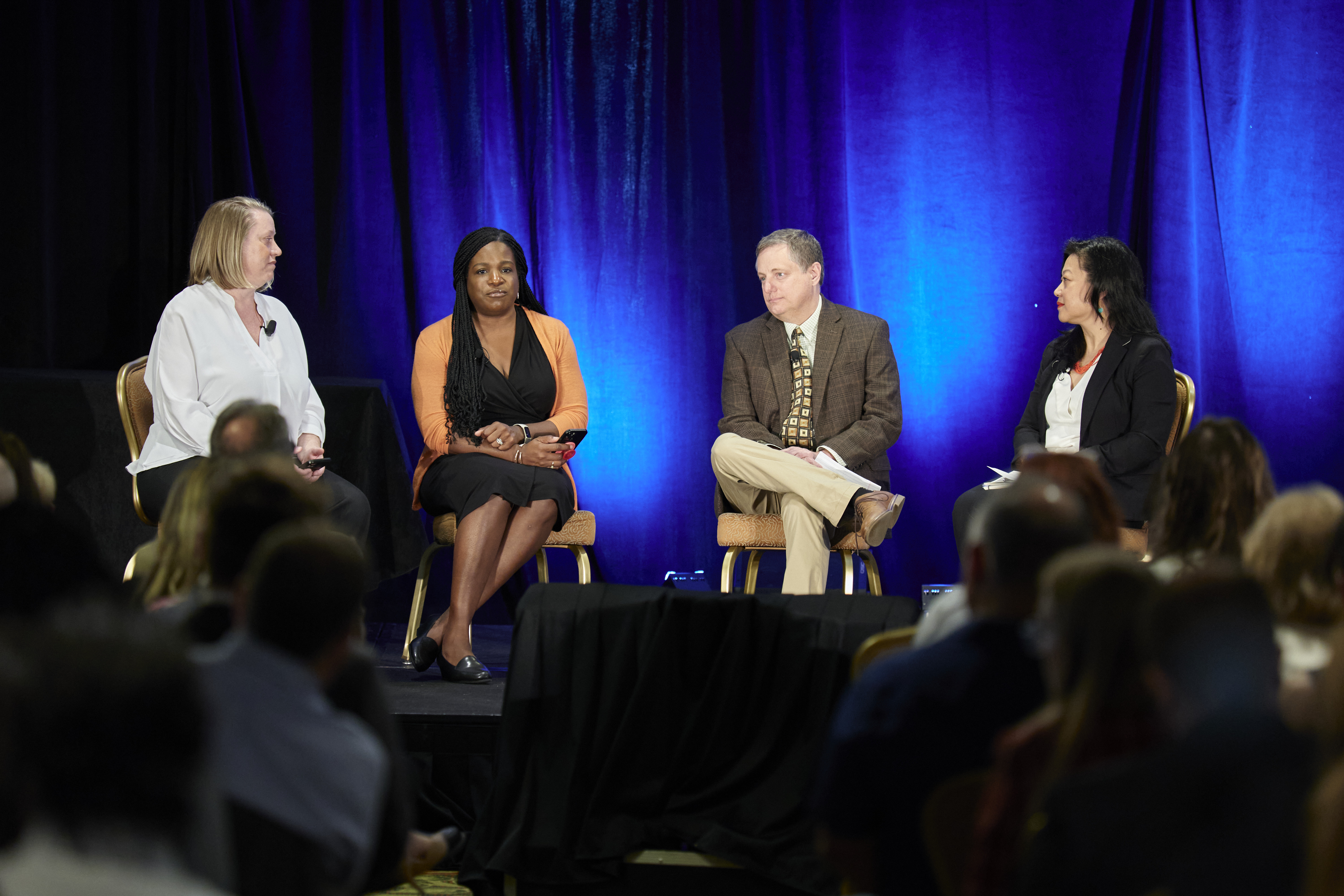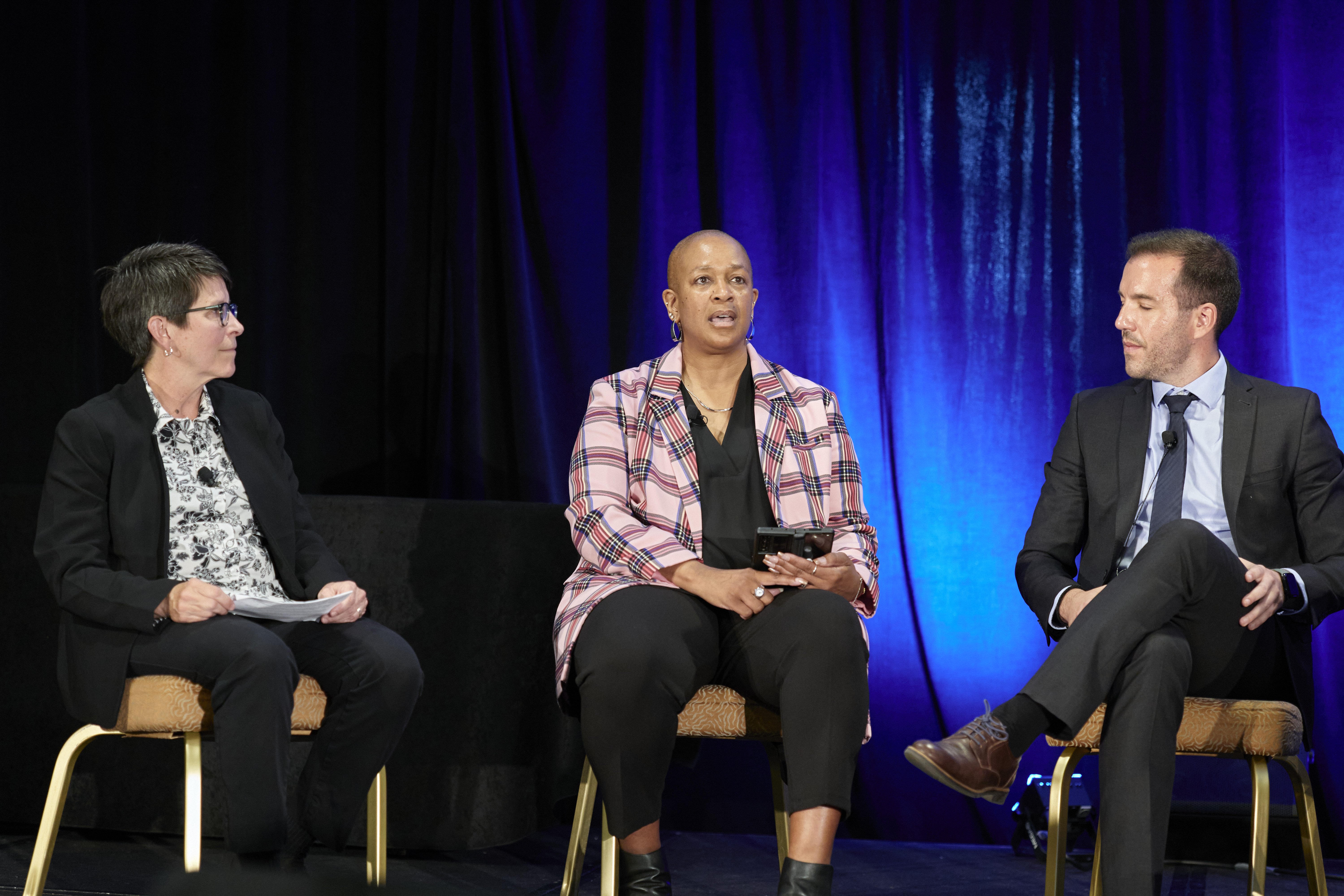For its first research conference in more than a decade, the National Institute of Justice (NIJ) focused on the theme of Evidence to Action. The conference’s many discussions all engaged with key questions about how the criminal and juvenile justice fields can take up research findings and apply them in policy and practice.
The breadth of NIJ’s research portfolios means that no single topic could adequately convey the full range of the Institute’s influence. Instead, the opening plenary was a series of discussions on three key NIJ research investments:
- DNA use in case clearance and wrongful convictions.
- Body armor standards.
- Spatial analysis of crime.
DNA for Case Clearances and Wrongful Convictions
The first panel in the session highlighted the impact of the considerable investment — over $110 million — that NIJ has made in forensic science research and development. Research in this area has invigorated the field, developed new knowledge and, more importantly, changed practices in criminal justice and outcomes for people who interact with the system.
NIJ’s Tracey Johnson facilitated the panel, consisting of Sarah Chu, John Morgan, and Melissa Taylor. This group, which represented the researcher, practitioner, policymaker, and advocacy perspectives, explored how research on DNA evidence has improved public safety and yielded more equitable criminal justice outcomes.
“NIJ has provided support for several influential lines of research on DNA analysis,” Johnson said, “and this research has produced alternative ways to interpret DNA; evaluated tools that improve DNA mixture interpretation; produced DNA testing methods for challenging samples; tested the limitations of DNA prevalence, persistence, and transfer; and generated best practices that recognize the need for efficiency and scalability.”
Johnson praised forensic science research and development as she asked the panelists about how NIJ’s investments have led to changes in crime laboratories and in the court systems while informing efforts to solve crime and promote justice.
Chu reminded the audience that, in the not-so-distant past, it was difficult to simply gather consensus that wrongful convictions existed. In an example of how early NIJ investments drove science-based research in forensics and resulted in data-driven policy, she recounted how former Attorney General Janet Reno and former NIJ Director Jeremy Travis recognized the importance of DNA evidence for exonerations.
The panel recognized that there is currently a shift happening in the forensic community. Research and development are expanding the boundaries of DNA testing and rapid DNA technology, DNA transfer, and DNA persistence and prevalence. The panelists agreed that researchers need to recognize how practitioners are implementing the technology and how courts use and perceive the evidence. As Chu put it, “we need to safeguard and consider how we ethically and legally use the data that is extracted from these methods.”
Melissa Taylor, who views her work through a social-technical lens, thinks about the impact of words on the way judges and juries interpret DNA evidence. Taylor mentioned the role of cognitive bias and potential bias in the way prosecutors and defense attorneys present data to the courts. She cautioned about the unintended consequences that may arise when DNA analysts rely on previously developed language, scientific jargon, or words with strong connotations that are prone to misunderstanding, emphasizing just how impactful the language practitioners use to address the boundaries of technology can be.
Throughout the discussion, it was clear that proper protocol is not just about using appropriate DNA collection and analysis techniques, but that translating the results of those analyses for courts is equally important.
John Morgan, who has conducted extensive research on the role of forensic evidence in wrongful convictions, expressed some concern about experts becoming too specialized. Experts who are limited to the scope of their expertise may find it increasingly difficult to communicate about their field with those outside of it. Apart from simply creating and adopting new technologies, he urged researchers to develop their ability to communicate the capabilities and limitations of new technologies with the public.
Morgan presented an example of a case where DNA technology was pushing the limits of what researchers could analyze with small amounts of DNA. In that case, the court threw out the DNA evidence because the laboratory had not observed the established guidelines and parameters for the technique they were using, rendering the analysis invalid. He recognized the fact that DNA evidence generally is quite powerful in influencing juries, so advised researchers to exercise care in conveying the strength of the evidence they present.
The discussion closed with an eye toward the future. Panelists discussed the advantages of using probabilistic genotyping, a mathematical approach to DNA interpretation that has altered the way DNA analysts describe the weight of DNA evidence.
To close, the panelists agreed that, given recent advance in DNA technology, the field needs more effective communication strategies to ensure that DNA evidence is collected and used in pursuit of justice.
Body Armor Standards: Saving Officers’ Lives
The opening plenary also featured one of the Institute’s longest running programs: standards and compliance testing for the protective body armor worn by law enforcement officers.
Since 1972, when NIJ published the first performance standard for ballistic-resistant police body armor, the NIJ Compliance Testing Program has made reliable armor a regular part of officer safety equipment across the country.
Mark Greene, director of NIJ’s Technology and Standards Division, nodded to this half century of history when he introduced the plenary’s panel on body armor. “I am just the latest in a long legacy of NIJ program managers and scientists and directors supporting this very important initiative,” he noted.
He added that since NIJ-certified armor first saved an officer’s life in 1975, the standard has been revised and updated six times in collaboration with the National Institute of Standards and Technology (NIST). These revisions are important to ensure that body armor can meet the demands of changes in firearms and firepower.
Amanda Forster, an engineer in NIST’s Material Measurement Laboratory who has worked on body armor innovations since 2003, described the immediacy of her work in this field: “I can really see a true impact of the research that I’m doing. I can meet the people that are actually using this equipment.”
Testing new models of body armor is not just an exercise in materials science. A rigorous testing program gives officers the confidence that their armor will perform as expected — and can keep them safe when a bullet or blade threatens their life.
Capt. Alan Hanson, administrative commander of the Fairfax County (VA) Police Department’s Public Order Unit, oversees his agency’s purchases of protective equipment. Without compliance testing to enforce these standards, underfunded agencies lured by lower costs may unknowingly purchase faulty body armor, he said.
“Standards are so vital. You count on the equipment to protect you, but if you don’t have standards, or you don’t have some type of certification, you’re left at the mercy of industry,” Hanson said.
Officers’ acceptance and use of body armor has not always been a given. Thor Eels, a former SWAT commander and now executive director of the National Tactical Officers Association, recalled, “I go way back to when body armor was very, very new to the profession — and it was optional. In most cases it wasn’t issued; if officers wanted it, they had to purchase it.”
He recounted the story of a fellow officer who had recently purchased armor but left it in the locker room when he went on duty; that day, the officer was shot and killed. Reflecting on this moment early in his career, Eels said of body armor that “it became very, very apparent to me that this had the ability to be literally life altering.”
Looking ahead to innovations in body armor and protective equipment standards more generally, Forster said, “What I would love to see is a materials innovation akin to that of the invention of Kevlar in the 1960s.” Materials that allow for lighter and more comfortable equipment are a promising direction for future research.
Work has been underway for several years to expand NIJ’s standards into what Greene called “the other parts of the police protective ensemble,” including public order equipment (also known as riot gear). NIJ published a standard for chemical, biological, radiological, and nuclear protective ensembles in 2010 and a bomb suit standard in 2012.
Envisioning a more comprehensive role for standards in law enforcement, Hanson made the comparison to fire protection. “Practically everything that a firefighter touches has a standard,” he said. “Why can’t we do that in law enforcement?”
NIJ released an update to the ballistic resistance of body armor standard along with a new accompanying standard, Specification for NIJ Ballistic Protection Levels and Associated Test Threats, NIJ Standard 0123.00, in the fall of 2023.
Spatial Analysis of Crime: Promoting Community-Based Safety Plenary
Improvements in computer systems and the availability of data in the 1990s produced new data-driven policing strategies, such as COMPSTAT and hot spots policing. These innovations sparked an enormous demand for information, tools, and research to support the use of data and spatial analytics.
In response, NIJ held conferences and sponsored the development of resources and software programs to make spatial analysis more accessible. Since that time, mapping law enforcement data has proved to be an effective way to analyze why crime occurs where it does, but it’s also brought unintended consequences concerning racial inequities.
The third panel of the opening plenary explored the impact of spatial analysis initiatives, their unintended consequences, and what the future holds for this field. The plenary was moderated by Liz Groff, a senior statistician at NIJ who previously served as the director of NIJ’s Crime Mapping Research Center.
Panelists pointed to the success of spatial analysis efforts in reducing crime, including the Newark Public Safety Collaborative and the Philadelphia Foot Patrol experiment, but also acknowledged the need to include a wide range of community perspectives in analyzing and understanding what the research shows.
“The data doesn’t become the end of the conversation. It’s just the beginning of the conversation,” said Alejandro Gimenez-Santana, an assistant professor of professional practice in the School of Criminal Justice at Rutgers University and director of the Newark Public Safety Collaborative.
Formed in 2018, the Newark Public Safety Collaborative is an alternative to traditional community policing practices. It promotes a data-informed approach that engages community stakeholders to mobilize community resources and expertise.
Since its founding, the Newark Public Safety Collaborative has grown to include participation from 45 community stakeholder groups. Arrests in Newark are down 45% due, in part, to the work of the Newark Public Safety Collaborative, according to Gimenez-Santana.
“When it comes to crime prevention, the community can play a leading role,” he said.
Widening the definition of community and ensuring that people with differing opinions are involved is critical in any discussion on spatial analysis, according to Tracie Keesee, co-founder, president, and chief operating officer of the Center for Policing Equity.
“There’s an exhaustion in Black and brown communities around experiments, science, and doing something where they’re not at the table,” she said.
Keesee emphasized that community means very different things in different places, and often researchers only invite people who agree with them to participate in projects. Instead, there needs to be collaboration among social scientists, psychologists, economists, and others. Law enforcement cannot be the driver of everything, she said.
The next evolution for crime analysis and spatial analysis is to understand its limitations, according to Jerry Ratcliffe, a former British police officer, criminal justice professor, and host of the “Reducing Crime” podcast.
Ratcliff said the integration of more community information, as well as greater understanding of social networks and what strategies communities are willing to tolerate and support, is the next step for spatial analysis.
“Crime mapping and spatial analysis tell you what’s going on, but criminal intelligence and community information will tell you why,” he said.
Should we close by sharing that NIJ’s next set of standards is forthcoming?
That's a great idea.




